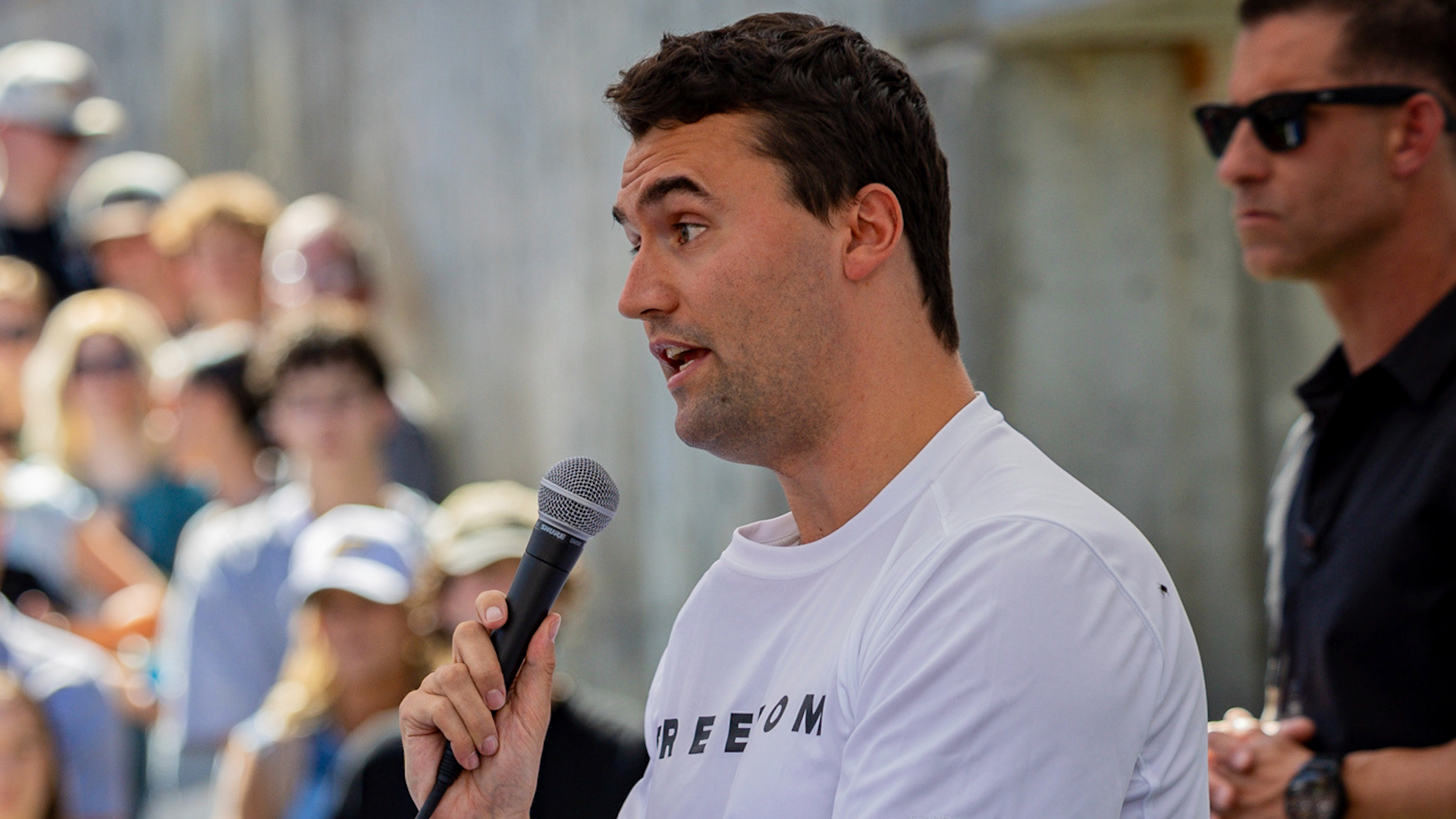The man with the unsettling look in the crowd — seen smiling just moments behind Charlie Kirk before chaos unfolded — has finally been identified. And his confession has left the public stunned. Experts say his behavior raises “serious unanswered questions” — and what he revealed just minutes ago might change everything.
It began with a single frame.
A still image taken from a live-streamed event — the moment before confusion swept through an auditorium, the moment before one of the most discussed incidents in recent public memory.
In that frame, standing a few rows behind Charlie Kirk, was a man with a faint, almost unreadable smile. Viewers didn’t notice him at first. The camera angle was off-center, the lighting uneven. But as the footage circulated online, sharp-eyed users began freezing the moment, zooming in, replaying it over and over.
And soon, the question everyone was asking wasn’t just what had happened to Charlie Kirk… but who was the man smiling in the background — and why did he look so calm when everyone else appeared confused?

The Frame That Started It All
The clip was only 14 seconds long, captured on a phone by a student sitting in the upper balcony of the University of Utah auditorium. At first, the video showed Kirk walking across the stage, gesturing toward the crowd, his usual energy filling the room. Then, suddenly, there was a pause. The audience gasped. The camera shook.
And in that chaos, just over Kirk’s right shoulder, stood the bearded man — his lips curving into what many described as “a strange half-smile.”
When the video first surfaced on social media, no one paid attention to him. Most people were focused on the event itself — the sound, the reaction, the confusion. But within a week, amateur analysts, podcast hosts, and countless users on X, Reddit, and TikTok began pointing him out.
“Who is that guy in the back?” one viral comment read.
“Look at his face — it’s like he knows something,” another user replied.
By the third week, the image had been screenshot over a million times.

Internet Detectives Go to Work
The internet does what it always does — it investigates.
Digital sleuths began tracking the man’s appearance. Some claimed he was a student; others thought he might be part of the event staff. A few even insisted he looked familiar — like someone they had seen in another clip, months earlier, attending a public lecture at the same university.
The man’s beard, his green jacket, the worn-out lanyard around his neck — every detail was dissected.
Then, one night, a forum post appeared titled simply:
“FOUND HIM.”
The post contained a blurred ID badge photo, matched by comparing facial features, and a name —
Ethan Ward.
Whether the name was real or not, the post spread like wildfire. And for the first time, reporters began calling local contacts, trying to confirm whether an Ethan Ward existed at the University of Utah.

A Knock at the Door
Two weeks later, journalists got their first official confirmation: yes, there was an Ethan Ward enrolled at the university. He was a graduate student in media production, known by classmates as quiet, polite, and — according to one of his professors — “intensely observant.”
When approached for comment, Ethan at first refused to speak. He deleted his social media accounts, stopped attending classes in person, and reportedly turned down multiple interview requests.
But the speculation didn’t stop.
People wanted answers: why was he smiling? Was it coincidence, timing, or something deeper?
That’s when a letter surfaced — a brief handwritten note allegedly from Ethan himself, sent to a local student paper.
It contained only three sentences:
“I didn’t mean for anyone to notice.
Sometimes people read too much into a single expression.
But maybe it’s time to tell the truth about what I saw that night.”
Within hours, #EthanWard was trending.

The Interview Everyone Waited For
When Ethan finally agreed to speak publicly, it wasn’t with a major network or national newspaper.
He chose a small, independent podcast called
Campus Voices.
The episode dropped at midnight on a Wednesday. Within an hour, it had half a million plays.
In the interview, Ethan’s voice was calm, deliberate. He described being in the audience that night, watching Kirk’s speech from three rows back. He said he noticed something unusual before the incident — a flicker in the lights, a sudden drop in sound from the mic, and a faint smell, “like burning wires.”
“People thought I was smiling at what happened,” Ethan said. “But I was reacting to the sound engineer in the back waving his hands. I thought something technical was going wrong. It wasn’t joy — it was confusion.”
He paused, then added softly:
“But there was something else — something I haven’t told anyone yet.”

The Whisper About the Lights
Ethan revealed that a few seconds before the chaos began, he saw one of the stage lights flicker three times, then burst in a quick spark.
“It happened right above Kirk,” he said.
“Everyone was looking at him — not at the ceiling. But I saw it.”
He claimed he even tried to alert the person next to him, but the noise drowned him out. When Kirk paused mid-sentence, the audience thought it was part of the show — until the tension became unmistakable.
Investigators later confirmed that one of the lighting rigs had short-circuited that evening due to a minor electrical malfunction. The report listed it as “non-hazardous.” But Ethan’s account suggested it happened seconds before the entire auditorium fell silent.
Suddenly, his presence — and his expression — seemed less mysterious, and more tragic.

The Online Turnaround
After the interview aired, the internet changed its tone.
The same users who had mocked him, calling him “the man who smiled,” began apologizing. Some even posted long threads acknowledging how easily misinformation spreads when people look for villains in blurry footage.
“I owe this guy an apology,” one Reddit user wrote.
“Turns out he wasn’t smiling out of malice. He was just caught in a bad moment.”
Ethan himself didn’t say much more publicly. He thanked a few supporters, then disappeared from the spotlight again. But the story didn’t fade. Instead, it shifted — from suspicion to reflection.
Inside the Investigation
Meanwhile, the university launched its own internal review of the event. Officials worked with campus security and an independent safety consultant to piece together what happened that night.
Their findings supported part of Ethan’s story: yes, a minor electrical fault had occurred. Yes, a technician had been waving toward the stage at the same time. And yes, multiple attendees confirmed that they, too, had seen flashes of light moments before the confusion began.
The report concluded there was “no indication of foul play,” but noted that “visual misinterpretations” on social media had contributed to a wave of misinformation that unfairly targeted bystanders.
Ethan Ward’s name was cleared officially. But by then, the damage had already been done — his photo, his expression, his supposed “smile” had already become a meme shared across millions of screens.
The Psychology of a Viral Moment
Media experts began weighing in. How does a simple facial expression — a flicker of emotion captured for less than a second — turn an ordinary student into a national mystery?
Dr. Mariah Jensen, a behavioral psychologist, told The Daily Observer:
“We are drawn to faces. Especially in moments of chaos, the human brain seeks meaning — we interpret what we see emotionally before logically. That’s how false narratives take root.”
She explained that online audiences often project their own feelings onto neutral expressions.
A half-smile becomes sinister. A blank stare becomes guilt.
“We forget that a camera doesn’t record context,” she said. “It only records angles.”
Ethan’s Second Statement
Weeks later, Ethan posted one final message to his private blog — his only direct words since the podcast.
It read:
“I’ve seen how fast the internet can decide who someone is.
I wasn’t a villain. I wasn’t a hero.
I was just there — in the wrong frame, at the wrong time.
Maybe that’s the real story: how we mistake coincidence for conspiracy.”
The post went viral again, but this time for a different reason. It wasn’t outrage — it was empathy.
People began using the hashtag #WrongFrameRightTime to share their own experiences of being misjudged online. Teachers, athletes, parents — even reporters — joined in.
Ethan’s story had transformed from a rumor into a cautionary tale about perception in the digital age.
The Frame Revisited
Months later, a documentary filmmaker released Twelve Seconds: The Smile That Fooled the Internet.
It re-examined the entire timeline — the event, the viral video, the social-media explosion, and the investigation that followed.
At the end of the film, the director freezes that original image again — the one that started it all. The bearded man, mid-expression, standing behind Kirk.
But this time, instead of looking suspicious, he just looks human — concerned, caught off-guard, trying to make sense of what’s happening like everyone else.
In a voice-over, the director says:
“We spend so much time trying to find villains in the frame, we forget that sometimes we’re all just background characters in someone else’s story.”
The Lesson Left Behind
The fallout from that night continues to ripple through campus culture. Journalism students now study the case in ethics courses. Professors use it to teach how digital virality can twist reality — how speed can outrun truth.
And as for Ethan?
He quietly finished his degree. He now works in documentary film, ironically helping others learn how to analyze video footage responsibly.
When asked recently if he regrets being at that event, he smiled — a genuine one this time.
“No,” he said. “Because if my mistake helped people slow down before judging, then maybe it wasn’t really a mistake.”
The Unseen Frame
The image of the man behind Charlie Kirk remains one of the most shared screenshots of the year. But its meaning has changed completely.
What began as suspicion ended as understanding. What began as accusation ended as awareness.
The world didn’t just learn who Ethan Ward was — it learned something about itself:
that sometimes, the most unsettling look in the crowd isn’t guilt… it’s just humanity, misread by a million eyes.
Final Reflection
The “man with the unsettling look” was never a villain — he was a reminder.
A reminder that viral moments aren’t the whole story, that a still frame isn’t the truth, and that empathy is often the first casualty of online obsession.
And maybe, just maybe, that’s the real lesson behind those 12 seconds the internet can’t stop replaying.
